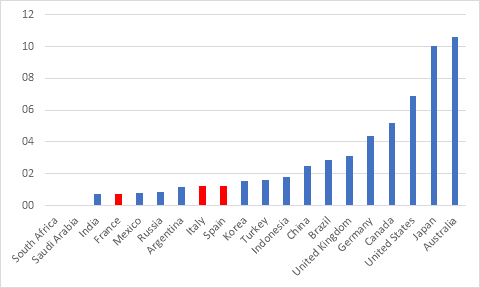Peter Bofinger argues that additional loans of inadequate amount do not add up to a rescue package which can save Europe from the coronavirus crisis.

The World Economic Outlook of the International Monetary Fund provides a first systematic assessment of the economic consequences of the coronavirus pandemic: it has triggered the worst economic downturn since the Great Depression.
In Europe, the southern countries are suffering particularly badly. Greece (-10.0 per cent), Italy (-9.1), Portugal (-8.0) and Spain (-8.0) are among the advanced economies anticipating the most severe slump in 2020. On average, the IMF expects a decline of 6.1 per cent for this group. In addition to very high exposure to the virus, southern Europe will be negatively affected by its high dependency on tourism, likely to be largely absent this year.
Debt ratios
The slump and high budget deficits caused by ‘automatic stabilisers’ and government support programmes inevitably lead to a massive increase in debt ratios (Figure 1). The increase is particularly pronounced in the same countries: in 2020, the ratio of debt to gross domestic product will likely exceed 200 per cent in Greece, 150 per cent in Italy and (by some way) 100 per cent in Spain, Belgium, France and Portugal.
Figure 1: gross debt to GDP ratio—forecast year-on-year increase and 2020 level
| Increase of gross debt/GDP, 2019-20 (percentage points) | Gross debt/GDP in 2020 (percentage) | |
| Netherlands | 10.0 | 58.3 |
| Ireland | 4.7 | 63.3 |
| Germany | 8.9 | 68.7 |
| Finland | 10.3 | 70.0 |
| Slovenia | 6.4 | 73.2 |
| Austria | 13.9 | 84.6 |
| Spain | 18.0 | 113.4 |
| Belgium | 15.8 | 114.8 |
| France | 16.9 | 115.4 |
| Portugal | 17.4 | 135.0 |
| Italy | 20.8 | 155.5 |
| Greece | 21.6 | 200.8 |
| Japan | 14.5 | 251.9 |
| United Kingdom | 10.3 | 95.7 |
| United States | 22.1 | 131.1 |
| Euro area | 13.3 | 97.4 |
| G7 | 19.0 | 137.7 |
The high level of debt already appears to be putting a brake on fiscal policy. According to IMF calculations, fiscal loosening—additional public expenditure and tax relief—is much less extensive in France, Italy and Spain than in Germany and large countries outside the euro area (Figure 2).
Figure 2: revenue and expenditure measures (percentage of GDP)

There is thus a risk that the fiscal stabilisation measures in the countries particularly affected will be insufficiently dosed. At the same time, these countries are pushing fiscally strong states, such as Germany, to reduce their aid, because they fear that this would put their own companies at a competitive disadvantage. This could result in the stronger countries also stabilising less than necessary.
In addition, the even higher debt ratios of southern-European countries could lead to the risk of sovereign-debt crises coming to the fore again on the markets—which could trigger another euro crisis.
Hot air
How have the member states so far reacted to this epochal crisis, which threatens the very existence of the European Union and the euro area? At first glance, one might be impressed by the fact that they have been able to mobilise a sum of €540 billion in a short time to combat the crisis. But on closer inspection, one can see this is a lot of hot air.
An amount of €240 billion is to be made available through the European Stability Mechanism. In contrast to before, these funds can be drawn on without an economic conditionality. As the financing framework of the ESM remains unchanged, however, they are not additional funds—so every euro used for Covid-19 measures will reduce the ESM’s available funds in the event of an emerging euro crisis.
An amount of €200 billion is to be made available as loans to companies from the European Investment Bank. To this end, the states are providing the EIB with a €25 billion pan-European guarantee fund—very optimistically assuming that a leverage of eight can be achieved.
Finally, as a new instrument, SURE (Support to mitigate Unemployment Risks in an Emergency) was created. It will allow for financial assistance of up to €100 billion in loans from the EU to affected member states.
In sum, the additional public funds comprise only €125 billion, which corresponds to 1 per cent of euro area GDP. Moreover, all are to be made available only as loans, which does not fundamentally address rising debt in southern Europe. If, in an epochal crisis, European solidarity is limited to raising such a small amount of funds and then not even providing it as transfers, it should come as no surprise if parties critical of Europe gain even more political influence.
Optimal solution
What would be the optimal solution? As much as possible of the additional debt should be transferred to the European level. A new fund should raise an amount of 10-15 per cent of EU GDP (€1.4-2.1 trillion) in the form of bonds. The funds would then be allocated to the member states as transfers, so that national debt would not be affected.
It would be conceivable to allocate the funds to all states according to their GDP shares, so that this would not involve transfers between the member states. Or there could be a mix, so that part of the funds would be allocated according to the extent to which the coronavirus crisis affected them.
As with the SURE mechanism, Article 122 of the Treaty on the Functioning of the European Union could serve as the legal basis. The funds could be perpetual bonds. The interest payments would have to be made from the EU budget.
Assuming that such bonds could currently be placed on the market at an interest rate of 2 per cent, this would result in an annual burden of 0.2 to 0.3 per cent of GDP. The member states would have to raise this amount through higher EU contributions.
‘Coronabonds’
So far, EU finance ministers have rejected ‘coronabonds’. But they have been positive about the possibility of a recovery fund. If it were structured according to the principles outlined here, that would be a big step forward. If the ‘frugal four’—Austria, Denmark, Sweden and the Netherlands—are not willing to change their position, however, nothing good can be expected for Europe.
Solutions such as restructuring the public debt in southern-European countries would be a recipe for disaster—this would destroy the savings of broad sections of the population. Debt reduction via a wealth tax would only make an effective contribution if it covered not only the super-rich but also the upper middle class. Reducing their wealth would destroy loan collateral and thus the scope for investment, which is urgently needed for the period after the crisis.
Some relief of the pressure on southern Europeans could be achieved by finally abandoning the completely obsolete 60 per cent debt/GDP target of the Maastricht treaty. It lacks any scientific foundation and if economic policy were to be evidence-based it would have been discarded long ago. If we look at the debt levels of the major economies (Figure 1), it becomes clear that much higher ratios are unproblematic—Japan’s is more than four times the Maastricht threshold.
ECB as saviour
In the end, it will probably boil down to the finance ministers betting on the European Central Bank as saviour, as they did during the euro crisis. With its pandemic emergency purchase programme (PEPP), which has an overall envelope of €750 billion, the ECB has sent a strong signal. Its president, Christine Lagarde, reiterated this on April 30th: ‘These purchases will continue to be conducted in a flexible manner over time, across asset classes and among jurisdictions.’
Nevertheless, it is dangerous if governments shirk their responsibility in this way. Critics of the ECB can then rightly question the democratic legitimacy of such comprehensive aid programmes and call for their review by constitutional courts.
It is therefore crucial that the frugal four abandon their opposition to a joint financing facility at EU level. Only in this way will the European project be able to survive and Europe respond to this terrible crisis in a manner as effective as in the United States. For, as the US economist Paul Krugman has put it, paraphrasing Franklin Roosevelt, ‘The only fiscal thing to fear is deficit fear itself.’
This article is a joint publication by Social Europe and IPS-Journal.
Peter Bofinger is professor of economics at Würzburg University and a former member of the German Council of Economic Experts.

